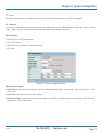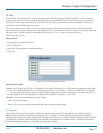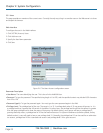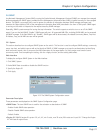
724-746-5500 | blackbox.com
724-746-5500 | blackbox.com
Page 25
Chapter 2: System Configuration
2.4 IP (Internet Protocol)
IP is an acronym for Internet Protocol. It is a protocol used for communicating data across an Internet network.
IP is a "best effort" system, which means that no packet of information sent over is ensured to reach its destination in the same
condition it was sent. Each device connected to a Local Area Network (LAN) or Wide Area Network (WAN) is given an Internet
Protocol address, and this IP address is used to identify the device uniquely among all other devices connected to the extended
network.
The current version of the Internet protocol is IPv4, which has 32-bits Internet Protocol addresses allowing for in excess of four
billion unique addresses. This number is reduced drastically by the practice of Webmasters taking addresses in large blocks, the
bulk of which remain unused. There is a rather substantial movement to adopt a new version of the Internet Protocol, IPv6, which
would have 128-bits Internet Protocol addresses. This number can be represented roughly by a three with thirty-nine zeroes after
it. However, IPv4 is still the protocol of choice for most of the Internet.
2.4.1 IPv4
The IPv4 address for the switch could be obtained via DHCP Server for VLAN 1. To manually configure an address, you need to
change the switch's default settings to values that are compatible with your network. You may also need to a establish a default
gateway between the switch and management stations that exist on another network segment.
Configure the switch-managed IP information on this page.
The Configured column is used to view or change the IP configuration.
The Current column is used to show the active IP configuration.
Web Interface
To configure an IP address in the Web interface:
1. Click System, IP Configuration.
2. Specify the IPv4 settings, and enable DNS proxy service if required.
3. Click Save.
Figure 2-8. The IP Configuration screen.
LGB1108A


















